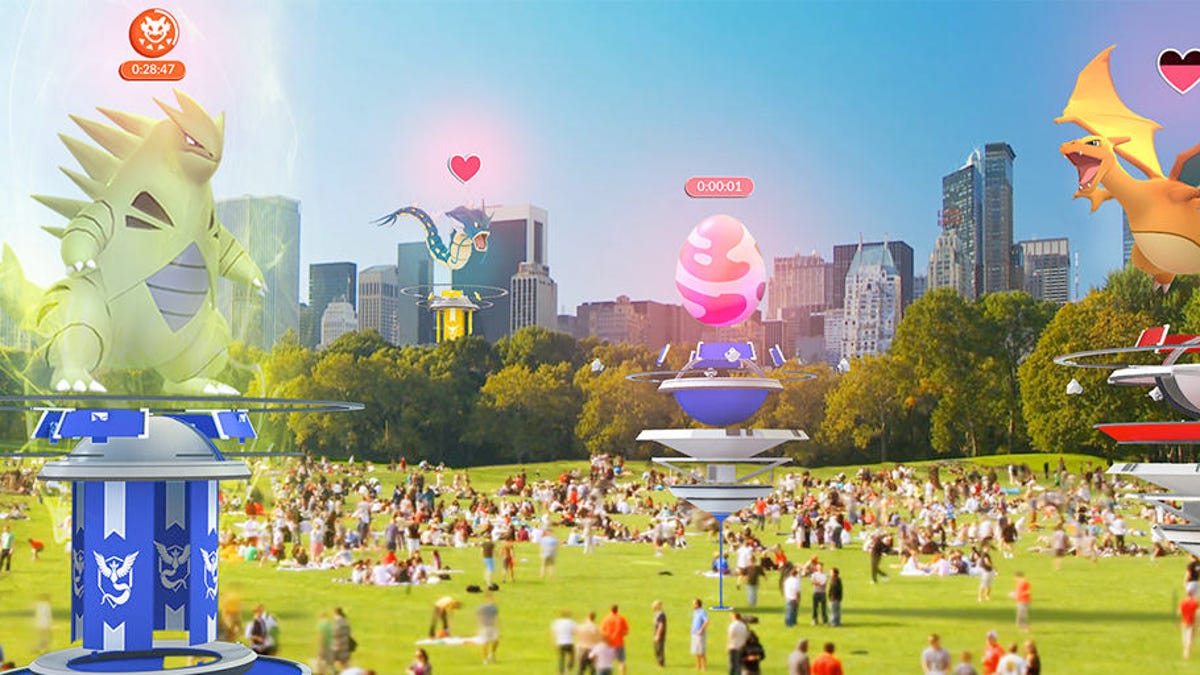Pokemon Go changed the way people look at their phones forever
One year later, it paved the way for where AR is heading next.

I still remember my walks to work last July, scanning my neighborhood's streets for Caterpies and Pidgies. Looking around, phone in hand like a pocket tricorder.
Last July, of course, everyone else joined in, too: at Starbucks, in Central Park, at zoos. It was a fad. It's also a foreshadowing of what's probably going to happen in mobile, and augmented reality, from here on in.
Augmented reality is the catchphrase of 2017 like VR was in 2016. Every major tech company seems to have its hand in it, from Google to Microsoft to Facebook, and most recently -- and maybe most impressively -- Apple. By this fall, many iPhones will be seriously adept little handheld AR devices, able to cast 3D objects into reality through the lens of the phone's little screen. Forget headsets for now: AR will be social, and communal, and mobile.
Just like Pokemon Go.
The first time most people will remember doing this with a phone.
This is how people will think of AR from now on
Some might argue that Pokemon Go isn't a pure example of augmented reality... and I'd say, of course it is. AR involves layering information into the real world.
Also, it doesn't matter. Most people still don't even know what augmented reality is, anyway. But they know what Pokemon are.
Besides, Pokemon Go does a lot of things right in AR. It's a pure representation of what layering information into a global map can feel like in the future, evolved from Niantic's previous app, Ingress. Ingress was the real beginning of social, mobile augmented reality, but Pokemon Go took those ideas and made them mainstream with recognizable characters. Pokemon Go doesn't always involve putting something into the real world perfectly and seamlessly, but who cares? Seeing a Squirtle next to your doorstep is good enough for most people, especially if it's nearly free.
Augmented reality's rise will mean a leap in apps trying to place things in the real world. Keeping track of them, and organizing them, will be a challenge. But Pokemon Go at least shows that forms of AR can be massively viral, and massively social.
I gave up on Pokemon Go after a few months. To me, it was a summer fad. And even though the player count has dwindled to mere tens of millions, it's become the most recognizable way to explain what augmented reality is to someone who doesn't know, or doesn't care to know. It's a clear example, unlike any AR app that came before. That's why you can expect a lot of "Pokemon meets X" pitches, or things being called the "Pokemon Go of AR."
Google's future of AR is handheld. So is Apple's.
And, based on its financial success, it's also a role model. According to Niantic's CEO John Hanke, Pokemon Go had 65 million users a month in April, and estimates suggest it's raked in well over a billion dollars. In comparison, the largest VR platform, Samsung Gear VR, has shipped roughly 5 million headsets, many given away for free with its Galaxy smartphones.
In mid-2016, while people were starting to get used to the idea of putting giant VR helmets on their heads, Pokemon Go took a hard left turn. Handheld phone-based gaming seemed like a totally different proposition. Things like this (including Ingress, or even older ARGs or geocaching) existed, but not at Pokemon Go's scale. And, compared to the huge wave of impressive but incredibly isolating VR platforms in 2016, Pokemon Go was overwhelmingly social.
Augmented reality, especially when handheld with a phone, isn't as deep-dive immersive as a VR headset. It's a lot more communal, though. The best AR concepts of the future will explore what it means to be social: in classrooms with selfie sticks (like Google Tango), or through shared lenses like Snapchat. Or, maybe, in geomapped social worlds like Pokemon Go. It's the best model I've ever seen for a shared phone experience.
Getting together with my son for a walk at the zoo and looking for Pokemon, or playing with his cousin on a summer weekend: these were personal moments. Talking to some random people at coffee shops about what creatures had wandered through a few minutes ago. Everyone looking at their phones, but everyone also playing together. Sharing a virtual world together.
VR doesn't have a single app that does the same.
It wasn't about AR, it was about being social.
Pokemon also transcended AR
Sure, Pokemon wasn't the first AR app. And, maybe, Snapchat could be considered the mainstream AR precursor, armed with its funhouse of eerily good face filters. But Snapchat's reality-altering vision, for the most part, aims inward through the front-facing camera. It's a self-reflecting mirror. Pokemon Go looks out, and so will most augmented apps.
But toss out the terms. Virtual reality, augmented reality. To most people, Pokemon was just about walking around and having fun with your phone. It was fun, and a lot people even played with AR mode turned off.
Apple's upcoming augmented reality toolkit for iPhones and iPads will allow all sorts of graphic tricks and realistic effects, making objects seem like they're floating in the real world in ways that Pokemon Go couldn't quite manage but for the same millions upon millions of people. What apps will emerge? Interior design, perhaps. 3D painting tools. Lots of cool realistic monsters and flying things. Oh, and better-looking Pokemon.
As app developers start scrambling to make their own killer apps for AR, though, they'll all be referencing Pokemon Go. Not necessarily because it was the best use of AR, but it was the app everyone used. Its sheer viral force made it the universal touchstone, and the ultimate example of success.
Who wouldn't want a piece of that?

